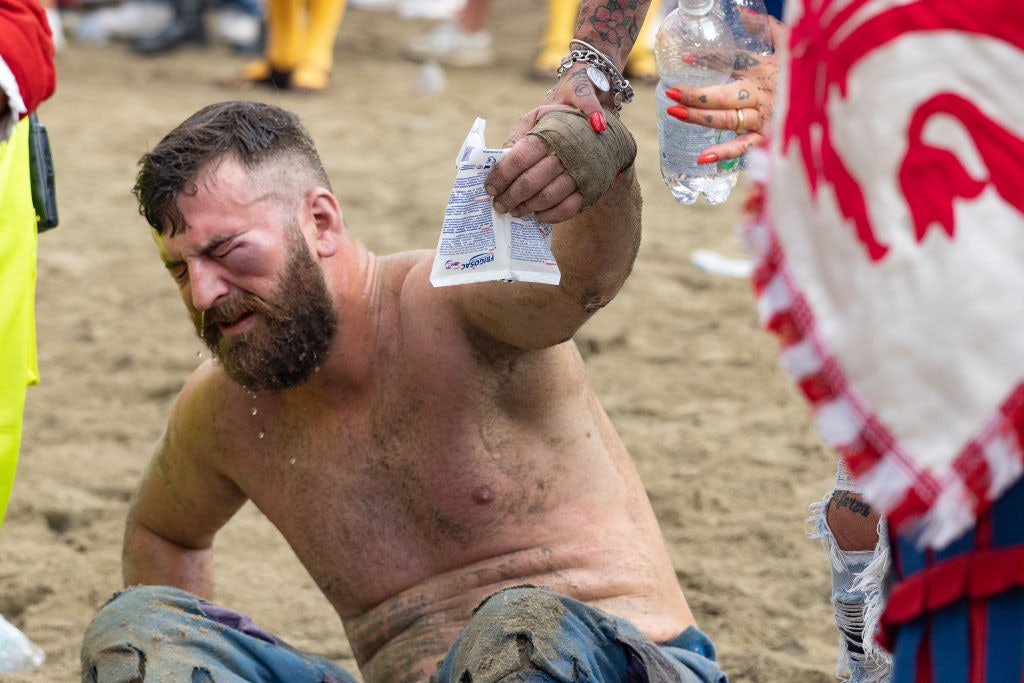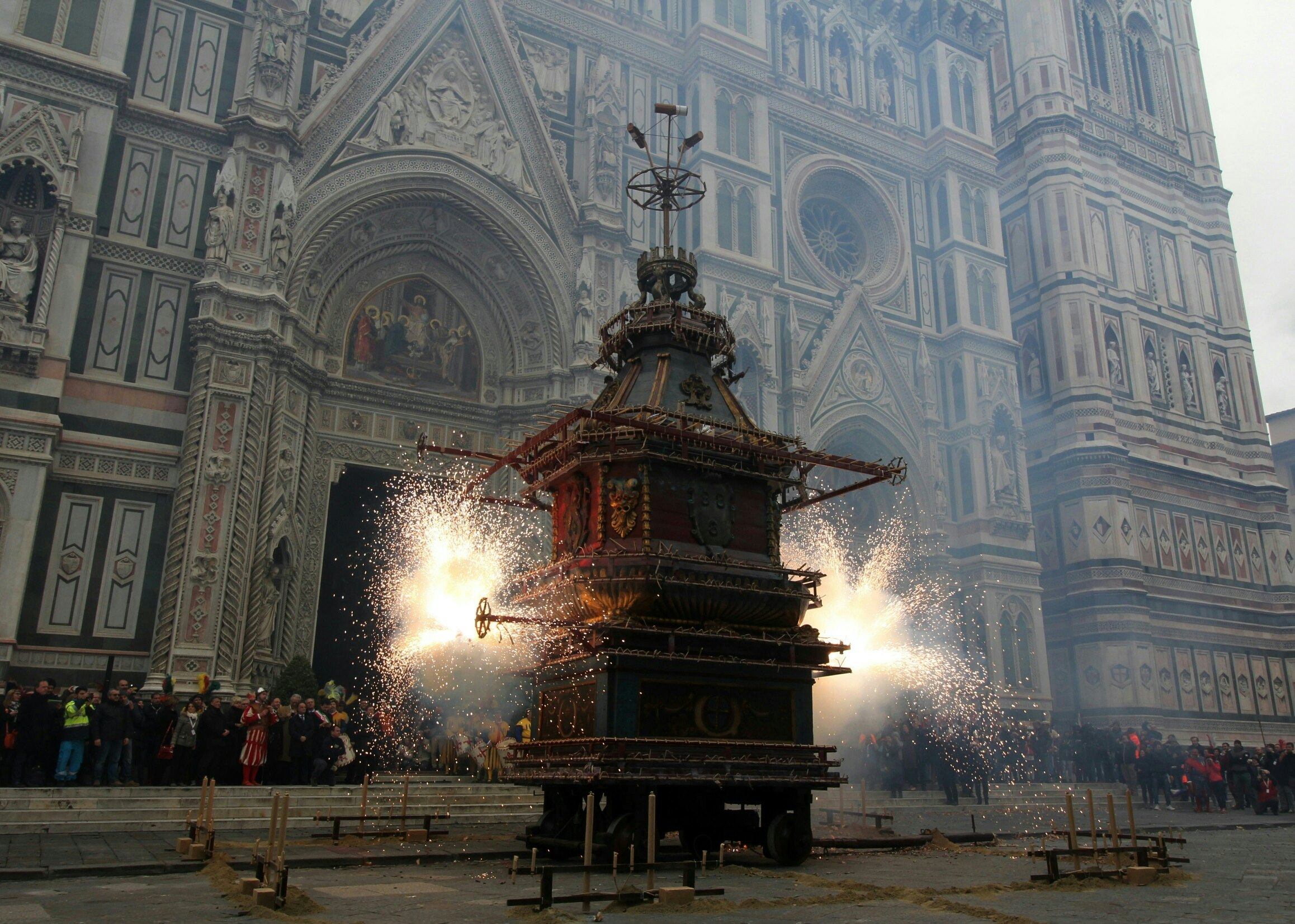
Nothing can quite prepare you for the reality of calcio storico in Florence © Megan Varner / Getty Images
When traveling through Tuscany in the warmer months of the year, it is not unusual to encounter parades of people wearing colorful, traditional clothing inspired by medieval culture. Historic reenactments are deeply rooted in local folklore, bringing Tuscans back to an era of city-states, tower houses, and clashing dynasties.
If a town in the region has been around for a while, you can be pretty sure there's a festival that pays tribute to its history. Siena has its Palio, Arezzo has its Giostra del Saracino, Montepulciano has its Bravìo delle Botti – I could go on and on. None of these celebrations, however, can compare to Florence’s calcio storico, held each year in June in Piazza di Santa Croce.
Picture this: fifty four (mostly bare-chested) men beating each other up on a 5000-square-meter sand arena – known as the sabbione – set up for the occasion in the heart of this Renaissance city, surrounded by 4000 cheering spectators and half a dozen ambulances ready to welcome injured athletes on board. It is just as brutal as it sounds – calcio storico is an early version of football that combines kicking the ball with boxing, wrestling and rugby-style tackles. The four teams represent each of Florence's historic neighborhoods – the Bianchi (Whites) of Santo Spirito, the Azzurri (Blues) of Santa Croce, the Rossi (Reds) of Santa Maria Novella, and the Verdi (Greens) of San Giovanni – and they give everything in pursuit of winning the title.
The origins of the calcio storico fiorentino
Although its origins are somewhat uncertain – the sport is regarded as an heir to harpastum, a game Romans played as early as the 1st century BCE – 1530 is typically referred to as the year when calcio storico fiorentino was born. Back then, football was already a popular pastime in the streets of Florence and elsewhere in Italy. The year 1530, however, was marked by an event that would remain stuck in the city’s collective memory.
In 1527, a violent revolt broke out in Florence against the ruling Medici family, who were ousted from power and expelled from the city. Florence became a republic, but this status was short-lived – Pope Clement VII, a member of the Medici family, struck a deal with Emperor Charles V, asking him to invade the city and reestablish the former government.
The siege was planned for February 17th, 1530. On that same day, a game of calcio had been planned in Santa Croce to celebrate Carnival. As a show of strength, the Florentines decided not to bow to the threats and play anyway. When Charles V’s troops reached the city, they found the Whites and the Greens busy kicking an air-filled leather football in Santa Croce, unmoved despite being on the brink of conflict.
That legendary game made it into history books as the "partita dell’assedio" (“game of the siege”) and inspired the contemporary reenactment that is still played today. Little is known about the popularity of the sport after the 16th century, but in 1930, to commemorate the 400th anniversary of the siege, the city council decided to reintroduce the calcio storico fiorentino tradition. Since then, it has been played every year in June.

The rules of the game
The rules have not changed much since the 16th century. A modern-day calcio storico match lasts 50 minutes. Two teams of 27 players known as calcianti challenge each other to score the largest amount of cacce (goals) on a 50-by-100 meter sand arena. Temperatures often surpass 30 degrees celsius. Each time a goal is scored the teams switch sides, but if a player mistakenly throws the ball over the net rather than into it, half a point is given to the other team.
The calcianti are allowed to attempt a caccia using any and all means available – they can kick the ball with their feet, throw it with their hands, and physically tackle opponents who stand in their way. Bare-knuckle punches, kicks, and clashes are all fair game. Violence is not just expected, but somewhat encouraged by the cheering crowds that populate Santa Croce’s pop-up bleachers, in an atmosphere reminiscent of millennia-old gladiator games.
In the past, blood spilled on the sabbione didn’t always come from athletic endeavors. Games have often turned into full-blown brawls involving both players and their supporters. In 2006 the tournament was suspended after the match turned into a mass fight, with 43 out of 54 players legally prosecuted after the dust had settled. The city council suspended the festival the following year to show how seriously they took the carnage inflicted on the streets. Stories of such incidents are often heard around Florence, especially during the weeks surrounding the tournament when locals enjoy reminiscing about the wild events of the past.
Rules were changed slightly in 2008 to ensure safety and avoid uncontrolled brawls. Only one-on-one clashes are permitted and athletes with serious criminal convictions are no longer allowed in the arena. This didn’t stop some of the Blues team’s players from hitting three referees in 2017, causing police in riot gear to intervene and stop the violence from escalating.
The calcianti are not paid to play in the tournament and they must all be born in Florence or have resided in the city for at least 10 years. The only prize for the winning team, besides the glory, is a Chianina cow with gold-painted horns.
Know before you go
Florence’s calcio storico tournament consists of three games: two semi-finals and one final. The final is always held on June 24, the day Florence celebrates its patron saint John the Baptist, while the other two games typically happen over a weekend in mid June. Despite the violent nature of the game and the incidents that have occurred in the past, it is safe to attend – that is, if you can get tickets.
Getting tickets
Make no mistake, this is a very popular event, beloved by Florentines and attracting increasing interest from outsiders. Tickets go on sale a few weeks before the start of the events and can only be bought in person at the box office on Via delle Vecchie Carceri 1 next to Le Murate. If tickets are still available after the initial sale, they are sold online via TicketOne.
With only 3000 seats available for the public (and 1000 for guests), tickets tend to sell out fast. Keep an eye on local newspapers for the announcement of the sale and get to the box office early. Prices start at €40.

The “scoppio del carro” fireworks on Easter Sunday
The first event related to the tournament is the Scoppio del Carro, which occurs each year on Easter Sunday in Piazza del Duomo. During this celebration, dating back to the 11th century, an ancient chariot is brought to the city's most famous square, escorted by soldiers, musicians, and flag throwers, and placed between the Cathedral and the Baptistery.
There, a small rocket shaped like a dove is set on fire, followed by a series of fireworks that symbolize the Holy Fire – the biblical miracle preceding the resurrection. During this event, which attracts thousands to Piazza del Duomo, there is a draw to establish which teams will play against each other in the semifinals.
Flag wavers and legendary musicians
The calcio storico tournament isn't just confined to the field of play – it involves celebrations that run throughout the city during the month of June. The first match is preceded by a grandiose performance by the Uffizi Flag Wavers and the parade of the Florentine Historical Procession. About five hundred sbandieratori (flag wavers) in medieval clothing cross the city to inaugurate the beginning of the games.
Flag wavers are not the only performers that take to the city streets in celebration. The Musici del Calcio Storico Fiorentino is the oldest musical band in Florence, active since the first calcio storico reenactment in 1930. The seventy musicians in the band open the celebrations with drums and flutes as they parade from the Santa Maria Novella to Santa Croce on the day of the first match. Their most elaborate performance, however, is seen in Santa Croce after the final, when the musicians form a circle to play the Inno della Victoria (Victory Anthem) in the sweat-soaked arena.
Once the games are over, a big party is usually held on the banks of the Arno river, where fireworks in Piazzale Michelangelo can be seen from all over the city.
Beyond folklore
As Florence's popularity as a vacation destination has grown over the past couple of decades, the calcio storico is often perceived as a spectacle for tourists rather than an actual sports tournament. However, this is not the case and, if you choose to participate, it's best to keep in mind that this is a heartfelt event that should be taken seriously. Athletes train hard throughout the year to get selected and be in the best possible shape, and ancient rivalries between historic neighborhoods still exist.

A calcio storico inspired lunch
The calcio storico tradition has made its way into Florence’s urban fabric – if you happen to visit the city and decide to get into the game’s atmosphere, you can eat at one of the restaurants that are either run by former calcianti or pay tribute to their neighborhood’s team. These trattorias specialize in local delicacies that are always served with a generous side of Chianti and stories from games past.
The Trattoria I'Raddi, in the Santo Spirito neighborhood, is run by one of the members of the Bianchi team and has long functioned as a gathering spot for the players. Every detail here seems to be a reference to great tournaments of the past, from the neighborhood’s coats of arms to the many pictures of athletes that have made history in the game.
Similarly, the Trattoria I’Brindellone, an old-school eatery in the San Frediano area, is adorned with nostalgic images of glorious calcianti, honoring both the simplicity of Tuscan cuisine and a sporting tradition that has deep roots in Florence's history but continues to thrive in the present.
Plan with a local





